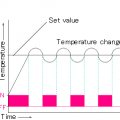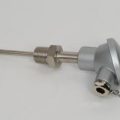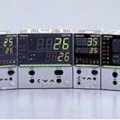■ 가열 냉각 제어는
예를 들어, 전자 기기의 성능 평가 시험을하는 경우에는 히터와 냉각 장치를 동시에 제어 할 필요가 생깁니다.
가열 냉각 제어는 하나의 조절기로 가열 및 냉각 출력의 2 계통의 출력을 조작하고 제어하는 방식을 말합니다.
일반적인 가열 냉각 제어 동작을 선택할 수있는 온도 조절기로 가열 측은 “역 동작”냉각 측은 “정 동작”으로 동작합니다.
역 동작 : 온도 측정 값이 증가하면 조절기의 출력이 감소하는 제어 동작을 말합니다.
(온도가 상승 → 가열 출력이 감소)
정 동작 : 온도 측정 값이 증가하면 조절기의 출력도 증가하는 제어 동작을 말합니다.
(온도가 상승 → 냉각 출력이 증가)
■ 가열 냉각 제어 PID 설정
가열 냉각 제어가 필요한 장치는 난방 제어 시스템 (히터 ~ 온도 센서) 및 냉각 제어 시스템 (냉각기구 – 온도 센서)는 2 개의 제어 시스템을 가지고 있으며 대부분의 경우, 가열 시스템과 냉각 시스템의 응답 특성 다릅니다.
따라서 조절기도 가열 시스템과 냉각 시스템에 적용된 PID 정수를 설정 할 수있게 만들어져 있습니다.
■ 가열 냉각 PID 정수의 설정 방식
가열 냉각 제어에서 PID 정수의 설정 방식은 두 가지가 어느 방식인지는 조절기의 기종이나 학년, 또한 조절기 제조업체에서 다릅니다.
① 비례만을 가열 및 냉각에 다른 설정이 가능한 타입
비례 설정 만 가열 시스템 및 냉각 시스템에 대해 “가열 비례 대」 「냉각 비례”고 개별적으로 설정이 가능하며, ‘적분 시간 설정’과 ‘미분 시간 설정 “은 가열 및 냉각에 공통 설정 를 사용합니다.
따라서, 가열 냉각 PID 조절기로는 「가열 비례 대」 「냉각 비례 대」 「적분 시간」 「미분 시간」의 4 개의 PID 파라미터로 제어 연산이 이루어집니다.
이 PID 정수 설정 방식의 경우, 설정 항목의 증가가 하나만 있기 때문에 조정 자체는 그다지 어려운이되지 않지만, 반면 치밀한 조정이라는면에서 제한 될 수 있습니다.
② 난방 제어 시스템 및 냉각 제어 시스템에 독립적 인 PID 정수 설정이 가능한 타입
가열 및 냉각 각각에 대해 독립적 인 PID 정수를 설정할 수 있기 때문에,보다 치밀한 상수 함께 포함 할 수 있지만 그만큼 PID 정수 설정의 최적화가 어렵습니다.
■ 가열 냉각 동작의 특징
① 설정 온도에 대한 온도 측정 값이 낮은 영역에서는 가열 측 높은 영역에서는 냉각 측 출력 값이 출력됩니다.
② 가열 및 냉각 출력의 전환 포인트로 불감 대 (데드 밴드)를 마련 할 수 있습니다.
③ 가열 및 냉각 출력을 오버랩시켜 출력 할 수 있습니다.
■ 가열 냉각 동작의 용도
액정 패널 : 가열 / 가스 냉각 / 가스
인쇄 계의 롤러 : 난방 / 전기 히터 냉각 / 물
유기 합성 : 난방 / 전기 히터 냉각 / 물
연속 재가열로 : 가열 / 가스 냉각 / 물
달걀 흰자 단백질과 다당류의 신규 복합 젤의 형성 : 난방 / 전기 히터 냉각 / 물
사출 기계 : 난방 / 전기 히터 냉각 / 물
식품 가공 기계 : 난방 / 전기 히터 냉각 / 물
활어 요스이 설비의 수온 관리 : 난방 / 전기 히터 냉각 / 물
일본 술의 “봐”제조 공정 : 가열 / 전기 히터 냉각 / 물
플라스틱 프레스 장치 : 난방 / 전기 히터 냉각 / 물
두유 : 가열 / 증기 냉각 / 물
금속 프레스의 원통 깊이 돌리기:가열/전기 히터·냉각/기름
기타 : 화학 · 의약 · 고무 · 섬유 업계의 반응 중합 · 결정화 · 용해 · 성형 · 응축 공정.
 HEAT-TECH 최선의 기술 온라인(on-line) 샵
HEAT-TECH 최선의 기술 온라인(on-line) 샵 










